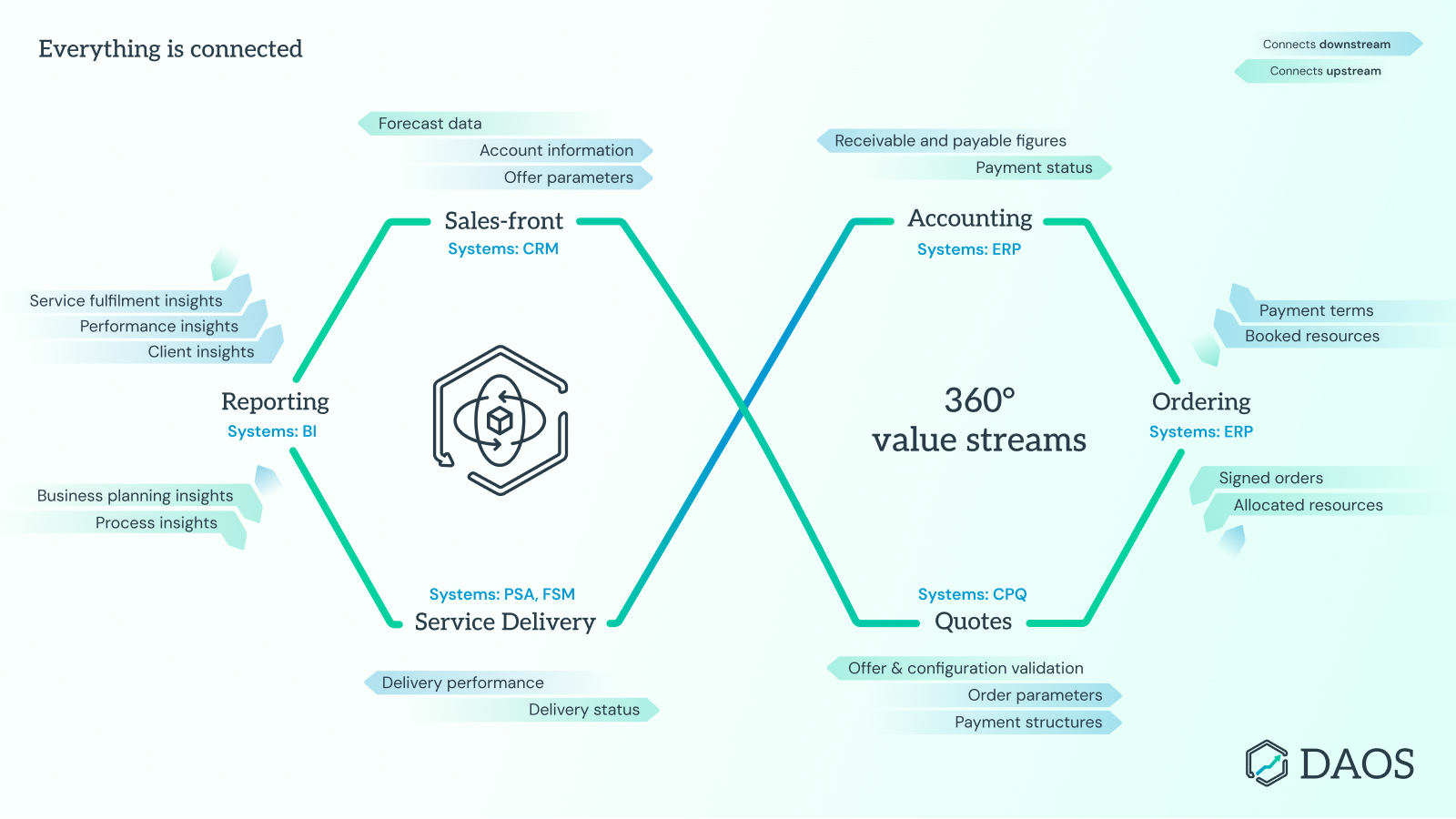"How bad can it be?" The importance of understanding that everything is connected
When I was sent to a subsidiary in Southeast-Asia to analyse their “opportunity to order” process, I expected some room for improvement, but boy was I in for a surprise.
The company had just finished a global transformation in an attempt to harmonise systems and processes across all countries and entities. By introducing a new CRM and CPQ, they were expecting to see client relationships, pricing and quoting improve across the board. When we arrived at the company's subsidiary, we knew that there were going to be “nuances” in how the subsidiaries were now running, but those “nuances” turned out to be a full-blown disruption to the entire company's performance.
At DAOS, we have a guiding principle: Always consider a 360 view of your value streams. Introducing a new system (or changing a process) in your business is never about fixing “one thing” or transforming “just” one part of your operation, it's about elevating all processes, from opportunity to revenue to cash, in the overall business model.
Adding a new CRM or Invoicing system needs to done with a 360 view of the whole value chain. There are key value streams that work in concert, and change has ripple effects across the organisation.
The 360 approach to value streams
In modern business, it is crucial to adopt holistic, interconnected business systems and processes. Departments or teams working in isolation or treating value streams as separate compartments will lead to breakdowns, often despite those teams performing at their best. Understanding how all value streams play as a symphony is key. When you aim to grow, scale, and remain competitive, nothing should exist in isolation.
What interconnected value streams look like
360 value streams have no silos, and data has clear and unambiguous ownership, with no double-ups or double-work hiding in neighbouring streams. Creation of data, checks, manipulations and transformations account for their upstream and downstream impacts. Consistency is key.
A 360 view of value streams seeks out risk inefficiency, data inaccuracy, fragmentation, and low-agility parts of processes. This way, the full value stream is an open road to scale your business, master operational excellence, and reach each new level of growth.
Back to my story about the subsidiary: Our analysis found 199 process steps, with 113 failing the 360 principle (that's 57%, well over half!). These came about due to changes made in silos, resulting in too many roles, unclear responsibility, and unclear upstream/downstream consequences. This, in turn, led to confusion, mistrust, anxiety and employee dissatisfaction. The next transformation led by our analysis saved over 52% in operational cost and halved the time taken to respond to clients.
Let's break down the key value streams from opportunity to revenue:
Sales-front
Interacting with potential and existing customers to understand their needs and uphold strong relationships. Relies on accurate data collection, and is the foundational stage for opportunity to revenue processes.
Strong client engagement drives client satisfaction and reduces churn while significantly increasing the chance for follow-up deals and long-term relationships.
Downstream
- Account information & Offer parameters connect to other values streams in a way that makes incredibly fast and reliable operations.
- The likes of account and client information must be as full and up-to-date for anyone who needs it in any stream. Every stream needs to be driven precisely by what the customer came to you for.
Upstream
- Forecast data connects all plans to move forward across your entire business
Quotes
Creating accurate and timely proposals based on customer requirements. Provides the bridge from engagement to sale, while maintaining or rolling out consistent and correct offerings.
Precise quotes tailored to the clients needs and expectations significantly increase win rates of opportunities.
Downstream
- Order parameters & Payment structures connect to stay up to speed with the every-changing client requests right up until an order is signed, and to eliminate last-minute fixes or gaps that cause delays in ordering, accounting, and delivery.
Upstream
- Offer & configuration validation connects directly to rapid sales. These details validate the conversation at the Sales-front, they ensure that the right quote is always ready to catch that crucial moment of decision to buy, and validate the insights/intelligence coming downstream, especially from post-sale Service fulfilment insights.
Ordering
Managing the allocation resources—products, services, or personnel.
Correct resource planning ensures that limited resources are not wasted and that the client gets the best possible and timely delivery. Reliability is key to client satisfaction.
Downstream
- Payment terms & Booked resource details connect to smooth accounting and common points of confusion from service delivery. With these details connected 360, client insights from reporting, future Sales-front engagements, and the experience across the entire account is elevated without extra cost and effort.
Upstream
- Signed order & Allocated resource details connect to follow-up deals at the Sales-front and faster quoting. We all know what it's like to order something that is “in stock”, only to find there's none left.
- This stream can drive reporting on where to create deals, fresh selling-points to take to clients, and the overall sense of reliability and repeat value for clients.
Accounting
(We all know this one!) Managing receivables and payables for ordered products or services. It ensures proper financial tracking and customer payment.
Accurate finance processes mean faster payments, better client engagements, better business intelligence, and smarter effort that translates directly into cash.
Downstream
- Receivable and payable figures connect to the bedrock of client-experience and business performance. They ensure financial agility and service reliability, such as the risks and benefits for new and existing clients, projects, or strategic priorities.
Upstream
- Payment status not only connects to client trust and effective business planning from financial reporting, but it connects to account growth through the trust and speed of future client engagements, quotes and orders.
- Who doesn't feel the importance of the difference between cash going in or cash going out!?
Service delivery
The core of what you do. Fulfilling the commitments made to customers through their ordered product and services, while striving for customer satisfaction.
Getting the delivery right builds trust and confidence in your business (by your clients and your staff), enabling follow up deals, market and customer relevance and higher margins.
Downstream
- Delivery performance metrics connect to... Well, if you don't have eyes on how your delivery is performing, how do you drive up repeat sales and service quality? How do you drive up profitability and catch inefficient costs of delivery? Need I say more!
Upstream
- Delivery status details connect to fast and pain-free invoicing, which connects directly to profitability and effective financial reporting, but it also connects to critical lower-level aspects like effective milestone billing as well as smooth and steady ongoing client engagements.
Reporting
Consolidating data from the previous value streams and various business processes, to generate insights for customer feedback and business decision making.
You cannot manage what you cannot measure, insights are crucial to remain competitive at scale and ensure the agility and efficacy of your end-to-end value creation chain.
Downstream
- Much like forecast data from the Sales-front, Service fulfilment insights, Performance insights & Client insights connect to effective business and strategic planning in every stream and every value creation process across your entire business.
- Connects to account visibility for clients and understanding growth opportunities such as what deals can be offered. It connects to invoicing accuracy, cost planning, investment and overall incomes.
- The downstream connections of reporting should be vast and plentiful. They provide every team member with the visibility and intelligence they need to enhance your business.
Upstream
- Business planning insights & Process insights connect to provide feedback to every value stream. You cannot improve if you do not have the insights that need improving, at the pertinent time (and the right headspace).
- These connections are the key to operational efficiency and continuous improvement, and the overall growth, profitability, client satisfaction of all value streams.
To ensure successful transformation, we very quickly look for data-accuracy, efficiency, standardisation, and customer-centric benefit, and ensure it is addressed early. By aligning the right value streams, we address how strongly they are impacted by a transformation, and what that transformation means for changes being made upstream and downstream of any given process. This makes sure your transformation has the greatest chance of success, and that the improvements permeate all of your operation.
By getting it right, DAOS can cut cost and effort by 30-50%, and best of all, make it easy to sell and deliver the right things!
Everything is connected
Using the 360 principle during transformation, we create a seamless end-to-end value chain while driving up efficiency and lowering cost. It drastically improves the quality of data, meaning that the insights that can be gained will further strengthen the client relationships and help identify future opportunities for growth or improvement.
Your teams will thank you for it. Your customers will love it.
It is all connected: Engaging customers effectively, modernising capabilities to empower your employees, building the systems and stewarding your data for future state readiness will ultimately mean you can scale and streamline your operations and transform your business and your products to get ahead, to reach the next level of your business.



